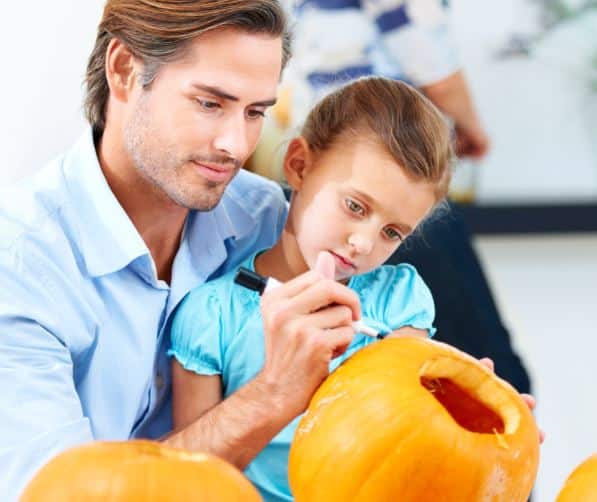Chair of Lingokids Advisory Board
What should parents know before trick or treating with kids?
Knowing a bit of the history of trick-or-treating might help you keep this exciting event in perspective. Approximately 2000 years ago, the Celts celebrated Samhain, which began on October 31 and lasted a few days. They believed that the dead returned to Earth on this day, and they lit bonfires and made sacrifices in honor of the dead. Celebrants would dress up to drive away ghosts or spirits. Over the years, with the influence of Christianity, the practice of “souling” developed; poor people dressed up and went to homes of the wealthy, promising to pray for them in exchange for cakes or treats. This was also associated with All Souls Eve, the night before All Souls Day on November 2nd, during which people prayed for the souls of the dead.
Over time, these practices evolved to children doing tricks—songs, poems, or other brief entertainments—in exchange for treats. There have been periods where the ”trick” part of Halloween has led to mischief—egging houses or cars, or performing other unwanted pranks. These days, Halloween can span a week or more, with visits to a pumpkin patch, pumpkin carving, elaborate costumes, parades, and parties. Although the complete history of trick-or-treating is not well documented, and children no longer prepare a “trick,” they do expect a treat to follow a knock on the door.
How should you involve your child in choosing their costume?
Children love to plan for Halloween, often weeks in advance. There is something magical about dressing up and getting free candy! When I was raising my sons, I made each of them a new costume in alternate years. During the intervening years, costumes were hand-me-downs or makeshift. We brainstormed what they wanted and negotiated just how elaborate the costume would be. Not all parents sew or have the resources to spend a lot of money on a costume that is worn once and then discarded. Parents should set some ground rules about expectations, what is acceptable for their community (rural, urban, suburban), and what is practical. Families living in urban settings, for example, may need to collaborate with other families to determine what events make sense for Halloween. A party? Collaborative trick or treating where people in an apartment building plan where children can knock on doors? A parade at a senior citizen center? A mall visit where businesses give out treats? Any of these can provide excitement and fun for kids in costumes.
How far in advance should you be planning a costume?
Finding the right balance is important for the weeks leading up to Halloween. With decorations and advertising appearing by September, the anticipation can be overwhelming. I didn’t mind deciding well in advance about the costumes. However, once the decision was made, the topic of Halloween had to be set aside until it was imminent. Children can be so over-stimulated at the ramp-up to Halloween, that the reality can be disappointing. And the abundance of candy after Halloween can wreak havoc with behaviors, both at home and at school.
There are homemade costumes that the children can help create and decorate, keeping them busy while building skills of creativity. For example, a robot costume can utilize decorated cardboard boxes that the child helps create. Think about what can be clever, current, and creative. Go through your closets or ask an older relative if they have old scarves or other items that can be used in a costume. A thrift shop is a great source of interesting accessories or clothing. Fortunately, there are lots of creative do-it-yourself ideas online.
Consider having a theme for the entire family: animals, movie characters (Alice in Wonderland or The Wizard of Oz), superheroes, candy bars, clowns, etc. Making Halloween a family event creates bonds and builds memories.
How to stay safe when approaching stranger’s houses? (flashlights, accompanying children, wearing a mask? inspecting candy) other helpful info?
With people worried about contaminated “treats” during certain periods, coupled with the risks of Covid during the past two years, Halloween has seen some changes. The days of roaming neighborhoods for hours has been abandoned in many communities in favor of more carefully managed events. Some businesses will host trick-or-treat events during a weekend. Families may get together for a party to substitute for going house-to-house.
Families who do trick-or-treat should have an adult or responsible teen escort young children when going from house to house. If possible, finish the rounds before dark. If after dark, carry flashings and make sure that costumes should have elements (reflective tape, for example) so the children can be seen at night. Without frightening the children, make them aware that they should not stray from the planned route or accept candy from strangers in cars or unexpected sites.
Take the same precautions that you adopted during covid—masks, hand sanitizer, and minimizing prolonged contact with any one person. Once home, a parent should check that the packages of candy are intact.
Be sure the costume is fireproof. One year I had my son pose for a picture in front of a candle…fortunately the damage from the flame was minimal, but it was a humbling moment when my son announced that his brother was on fire!
Carry a few bandages with you while trick-or-treating. It’s easy to trip over those costumes and a bloody knee can ruin a child’s evening.
Halloween Alternatives

Last year I invested in a full-size skeleton, and I changed its outfit or theme daily for a few weeks before Halloween. She cooked, wrapped up in blanket on a cold day, read scary books, and even knitted. The skeleton required a financial investment, but I knew that I wouldn’t have to purchase candy to distribute due to my neighborhood. And I’ll be able to repeat this yearly.
Consider a movie marathon—all the favorite scary movies, age appropriate, plus homemade popcorn balls. Have a scavenger hunt. While I was homeschooling my grandkids during Covid, we had a party that included being blindfolded (with Covid masks!) and guessing the witch’s “body parts:” olives for eyes, spaghetti for veins, yarn for hair, etc.
Look online for decorating and craft ideas. They can range from simple to elaborate, involving the entire family. Consider turning your front yard into a zombie, pumpkin, or corn maze. Do a scavenger hunt. Challenge the family to come up with the best ghost stories and have a “scare” night.
Finally, if you want to enhance Halloween, consider a philanthropic venture. Trick or Treat for UNICEF is a wonderful annual fundraising event. Consider having a project to support a local charity. Treats for Troops is another way to dispose of extra candy. For more ideas, check online for fundraising or donation ideas, and make a difference!


